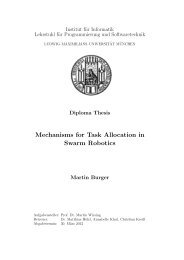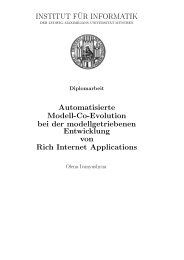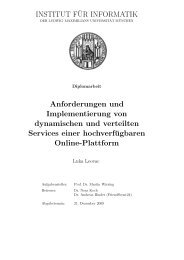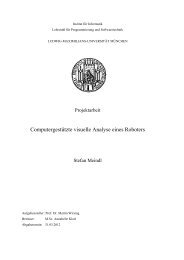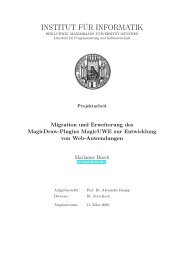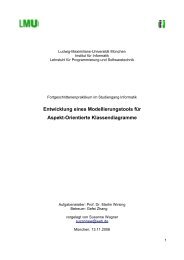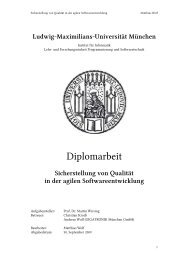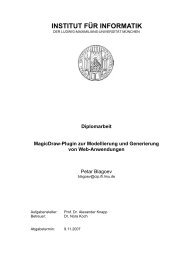institut f¨ur informatik - PST Thesis Management Interface - LMU
institut f¨ur informatik - PST Thesis Management Interface - LMU
institut f¨ur informatik - PST Thesis Management Interface - LMU
Create successful ePaper yourself
Turn your PDF publications into a flip-book with our unique Google optimized e-Paper software.
2.1. Model-Driven Software Development<br />
acting logical components, including their behavior. The logical components provide<br />
functionalities described in the requirements model.<br />
• The technical architecture defines the deployment architecture, i.e. all hardware units,<br />
the basic software (operating system and middleware) on them and their connections -<br />
controllers, communication devices, actuators and sensors, as well as a mapping from<br />
the logical architecture (its structures and behaviors), to this deployment architecture.<br />
• Behavioral models specify the functionality at a detailed level and allow the generation<br />
of production, simulation and test code.<br />
The work in [NH08] is motivated by the increasing integration of external devices and external<br />
communication into the vehicle. The authors focus on developing a facility for modeldriven<br />
development of embedded software that enables modeling from multiple viewpoints.<br />
The viewpoints include the functional viewpoint, software structure viewpoint and humanmachine<br />
interface viewpoint. They achieve this by extending a modeling facility that has<br />
been proven successful in body electronics ECUs to the system level and the infotainment domain.<br />
Furthermore, they include the associated requirements for wireless connectivity. This<br />
way, they bring the different viewpoints together in a set of models. These models provide a<br />
possibility to handle the associated complexity and ensure the quality of the vehicle software.<br />
In [GHH04] the use of well-understood mathematical modeling frameworks that allow formal<br />
verification of a system is emphasized. The background idea is early detection of bugs and<br />
problems in order to achieve a more efficient embedded software development process. The<br />
developed model-driven process places strong emphasis on performance and as much testing<br />
and verification in tight-loops as possible. The models and controllers are framed in the<br />
context of hybrid automata.<br />
Software variability in automotive systems refers to deploying varying controller software<br />
on the same ECU (while maintaining the same principal software structure) according to<br />
different customer requirements. During product configuration (configuration of the ECU<br />
software according to customer needs), specific class variants have to be selected (see section<br />
3.1.2). Selecting the right combination of variants for a certain product is error-prone because<br />
of the vast number of variants. Knowledge about dependent variants and conflicting<br />
variants is currently not explicitly included in models, but it is up to the software engineers<br />
to be aware of such dependencies and to resolve them. A solution to this problem is proposed<br />
at system design level in [Gri08] by extending existing tools to allow explicit modeling of<br />
dependencies between variants through creating appropriate metamodels.<br />
A model-driven method for building embedded component infrastructures based on the<br />
combination of component/container infrastructures is developed in [VSK05]. In particular,<br />
automatic code generation is used to create infrastructure code required to make the<br />
application logic work in the context of the embedded system’s hardware infrastructure.<br />
Building a software infrastructure for embedded components is also one of the central issues<br />
addressed by AUTOSAR. This extensive application of MDSD in the automotive domain is<br />
concerned in this thesis and is presented in detail in chapter 3. In particular, AUTOSAR<br />
addresses the logical and technical architecture mentioned above.<br />
11



